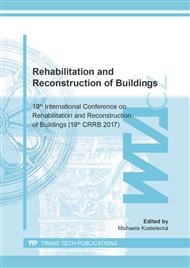p.3
p.9
p.15
p.23
p.29
p.37
p.41
p.46
The Comparison of Moisture Balance of Diffusion-Open and Diffusion-Closed Structure of a Building Envelope
Abstract:
This article is oriented toward the heat-moisture behaviour of the wooden construction sheeting. The behaviour of building envelope is evaluated according to the heat transfer coefficient and foremost from the view of the condensed vapour amount inside the building envelope structure. For exemplary building envelope will be elaborated model calculations and then they will be compared. The results have shown that diffusion-open structure has the best characteristics concerning the heat-humidity behaviour and ecology of wooden constructions.
Info:
Periodical:
Pages:
23-28
Citation:
Online since:
August 2018
Authors:
Price:
Сopyright:
© 2018 Trans Tech Publications Ltd. All Rights Reserved
Share:
Citation:


